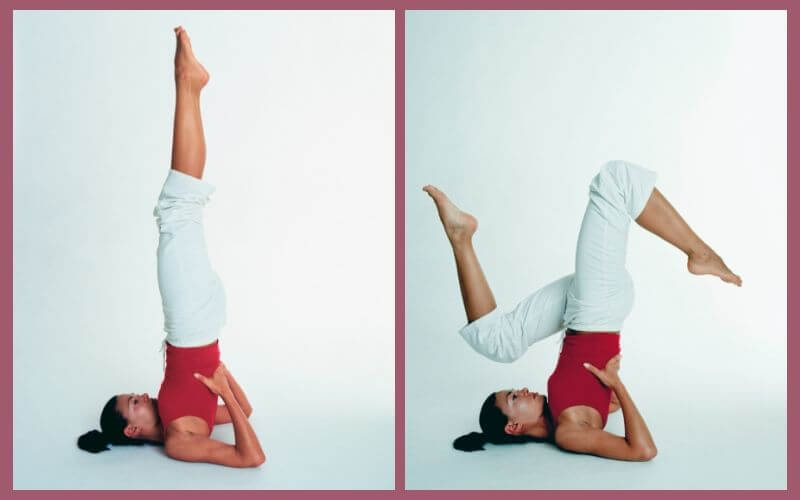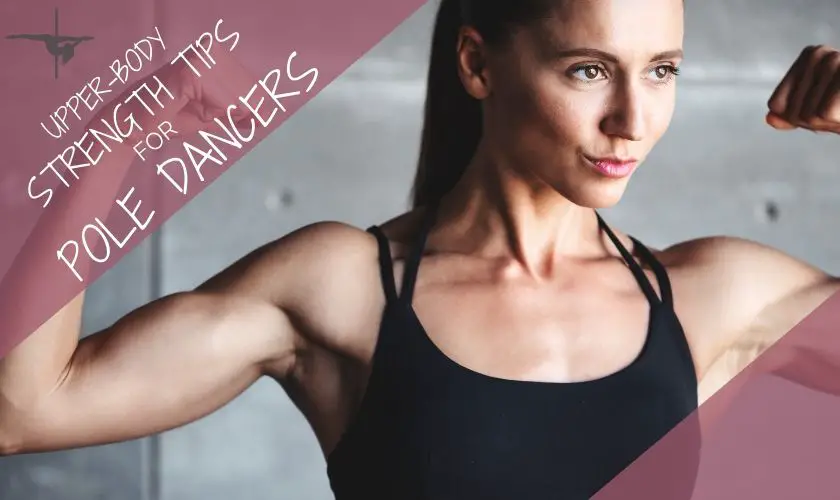Last Updated on February 26, 2023
So, you’ve started pole classes and you’re wondering “When the hell am I going to be taught how to do a pole invert?”
We get it. Inversions are one of the more impressive elements of pole dancing (the kind that makes your friends go ‘oooooooooh’) yet pole pros call it a ‘basic’ invert.
Well, a pole invert ain’t that basic!
Performing even a ‘basic’ invert requires a combination of strength, flexibility, and correct technique to execute properly.
Quick Summary
- Inversions are an impressive pole dancing trick which require strength, flexibility, and correct technique.
- You can expect to invert after about 3-6 months of regular lessons, conditioning, and practice.
- Jumping or kicking into an invert is not the safest method and can potentially lead to injury.
- Conditioning exercises such as the knee tuck can help prepare the body for inverting on the pole.
- It is important to condition both sides of your body as one side will naturally be stronger than the other.
In this blog post, we will delve deeper into the world of inversions, giving you the lowdown on when you’re likely to be able to invert successfully and some tips for how to get started conditioning your muscles.
So before you get frustrated with you perceived lack of progress, remember that inverting on the pole is not a beginner’s trick.
Are You Learning To Pole Dance?
Check out our complete guide on pole dancing for beginners – this covers everything that you need to know about pole dancing for fitness (and more!)
So, When Can I Invert On The Pole?
When you’re strong enough to successfully and safely invert on the pole is different for each person. Some learners develop strength faster than others. Generally speaking, a beginner pole dancer can expect to invert after about 6 months of regular lessons, conditioning and practice.
But this may be sooner for some people.
You definitely won’t be inverting on the pole during your first lesson, second lesson or probably even your tenth lesson.
However, you can begin to condition in preparation for your pole invert from the very first lesson!
Why Can’t I Invert In My Second Lesson?
It’s extremely unlikely that you’re strong enough to safely complete a pole invert after just one lesson.
Performing a pole dancing trick such as an invert requires above-average levels of strength, agility, control and a good understanding of the correct technique.

Is It Safe To Jump or Kick Up Into a Pole Invert?
Many pole dancers jump or kick into a pole invert and while they may do so unharmed, it’s not the safest method of inverting on the pole.
It’s easier to injure yourself by jumping into a pole invert. By jumping there’s a risk that you could knock your hip, knee or ankle on the pole which will leave a bruise (at best) or at worst, cause a more serious injury.
Also, if you’re not yet strong enough to invert, you can end up with your body in the wrong position with your shoulders rounded and your chin curled inwards.
Learning good form is important.
If you start inverting by kicking, you’ll soon get into the habit of it (it is that little bit easier, after all) – so why not learn good form right from the start?
Some instructors and studios actually encourage jumping or kicking into inverts, which encourages bad form in the long term.
It’s understandable why some instructors allow kicking up into an invert, it allows you to get a sense of achievement and experience the sensation of being inverted on the pole.
Some learners get frustrated with the lack of progress and in the fear that they may quit their classes, instructors sometimes feel compelled to ‘allow’ their students learn more advanced moves such as the basic pole invert.
See also: Pole dancing studio red flags
How To Condition For A Pole Invert
There are a few different ways you can condition your muscles in preparation for an invert. Remember – you can start doing these conditioning exercises right away!
Want to become an amazing pole dancer?
Open Dance Academy has over 450 online lessons, by some world famous pole dancing champions! Join now to get:
***GET 10% OFF OPEN DANCE ACADEMY***
Use the code polefitfreedom to get 10% off Pole Dancing Lessons with Open Dance Academy. This is an exclusive offer for readers of this blog!
Method #1: Knee Tuck
The most common pole inversion conditioning exercise is the knee tuck.
See also: How improve your grip strength at home
Step 1: Start On Your Strong Side
Make sure you’re standing on the side with your strongest arm on top. Ideally, you condition your muscles for inverting while standing on both sides of the pole.
One side will always be more difficult than the other – this is natural.
Everyone has a strong/good side and a weak/bad side.
Even so, you should aim to condition both sides anyway to strengthen your “weaker” side in the long-term.
Step 2: Baseball Grip & Hips Forward
Stand with the pole to your side and hold the pole with your hands in the baseball grip position (as if you’re holding a baseball bat).
Your strongest hand should be on top.
Also, your hips should be facing forward with your butt slightly in front of the pole. This position alone can take some getting used to, so if it feels strange to you, get used to standing in that position for a while first!
Stand on your tiptoes and point your toes (if you can) during this conditioning exercise.
Step 3: Knee Tuck
Make sure you have a firm grip on the pole with both of your hands, using a grip aid product if necessary.
Then, begin then downward ‘pulling’ force on the pole with your hands, shoulders and back.
At the same time, lift your knees up toward your chest.
Hold that position for a second, then lower your feet down to the floor.
Try to land softly (controlled) if you’re able to. This can take some practice!
Step 4: Repeat For 3 Reps
Repeat this motion 3 times to begin with. As you get stronger, you can increase this to 5 times.
Step 5: Switch sides!
Now it’s time to perform the same motion on your “bad” side. But don’t worry – it’s totally normal to find it more difficult on this side.
But you should still try. It will make you better pole dancer in the long run.
Method #2: Shoulder Stands From The Floor
Believe it or not, shoulder stands from the floor are an excellent way to condition for your pole invert even though this move is performed on the floor.
Inverting on the pole is not just about your upper-body strength – you need a strong core and lower body too!
A shoulder stand mimics the position of a pole invert quite closely.
You can perform a shoulder stand with the pole next to you on the floor. Hold the pole using the same ‘baseball grip’ mentioned in the previous method. Grab your yoga mat for this.
It really helps to have your phone’s camera on when practising your shoulder stands from the floor so that you can see your angles, lines and where to improve.

Tips For Getting Your Pole Inversion
- Always warm up before performing a basic pole invert. You should never launch yourself upside down from completely cold – this is a one-way-ticket to pulling a muscle and having to take some time out!
- Work with a spotter when you’re learning to invert. Having an experienced spotter with you is important. Inversions are intimidating moves without much room for error. Your spotter should ideally be an experienced pole dancer or instructor who is familiar with the trick.
- Get a perfect knee tuck first. Make sure you can comfortably perform your knee tuck before attempting to invert. When you’re comfortable in that position, it’s time to lean your body back and put your head back – that’s the next step!
Conclusion
To conclude this guide, remember that a pole inversion is a move that requires above-average levels of fitness – so don’t worry if it takes you time to get there.
Performing inversions on the pole are one of the most rewarding parts of pole dancing.
Once you can invert – you can then start working towards your aerial invert (inverting after climbing up the pole first!) which is a whole other challenge – another goal to work towards!
Happy Poling!
Want more Pole Tricks?
Get your copy of the Pole Tricks Handbook – includes Basic Invert plus hundreds more!






